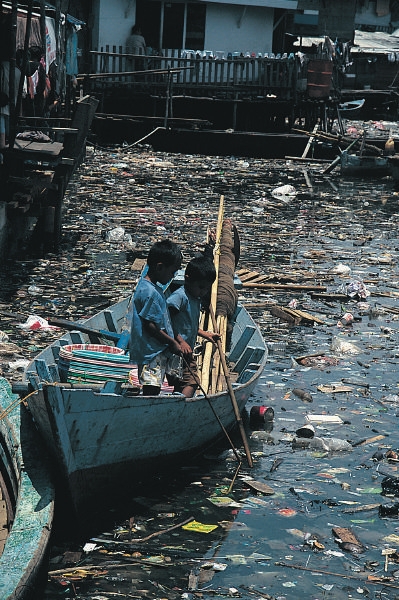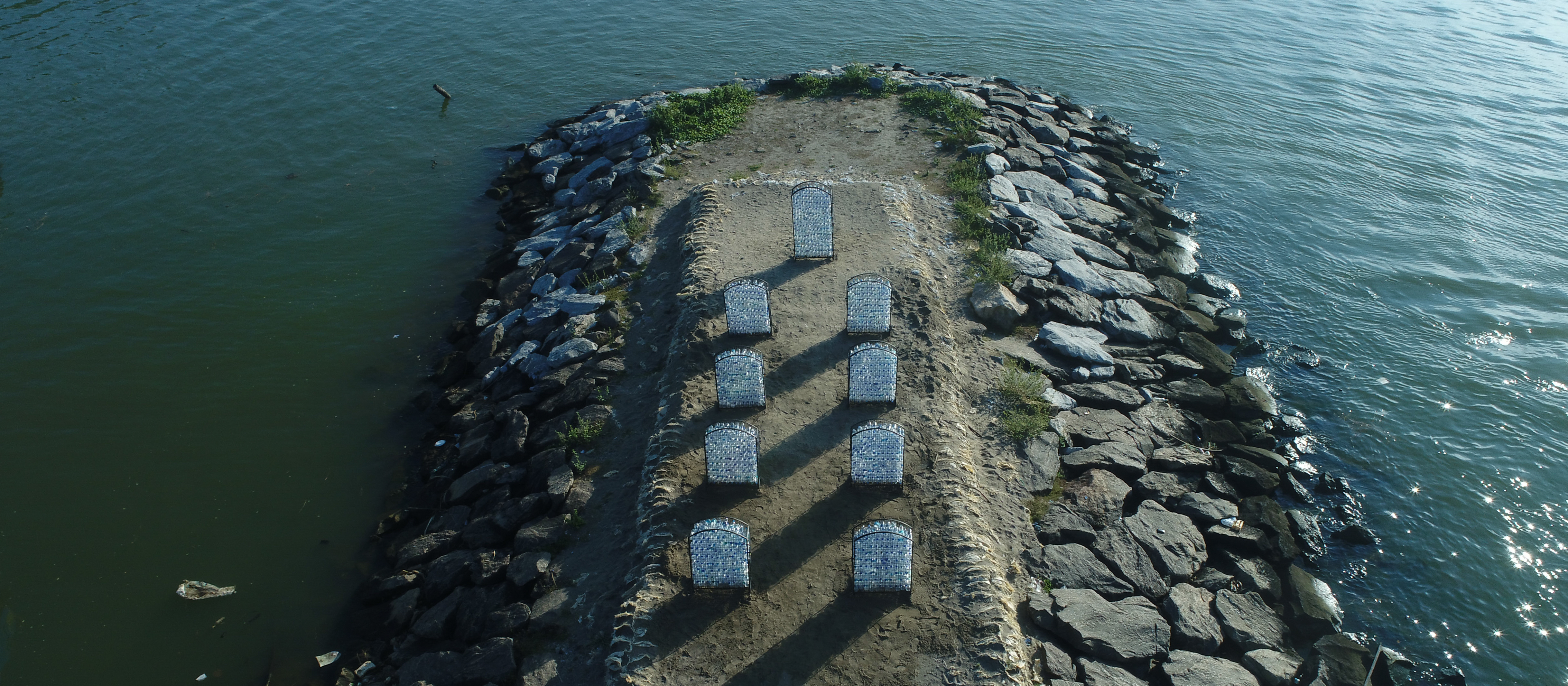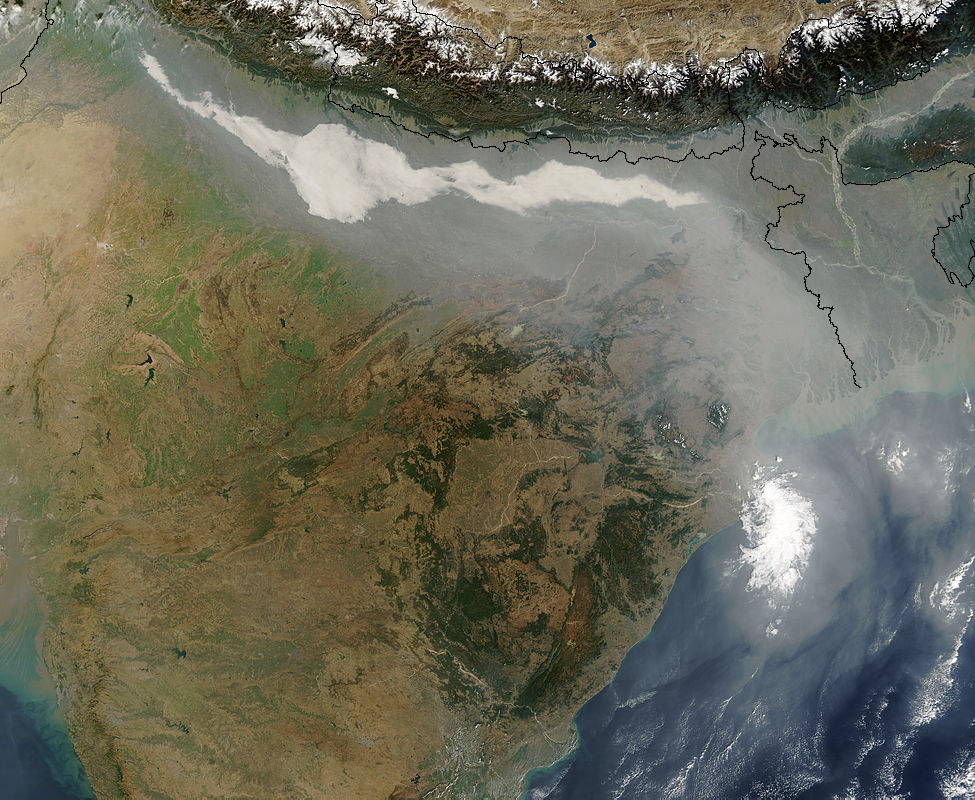|
Single Use Plastic Deathbed
The Single Use Plastic Deathbed is an art installation at Freedom Ghat on the bank of Ganges, Ganga river near Laxman Jhula in Rishikesh, Uttarakhand, India. It features three Pyre, funeral pyres made from Disposable product, single use plastic waste. The installation was opened in December 2020. History Climate activist Aakash Ranison organised six waste cleanup drives in various tourist places in Rishikesh with help of volunteers in September 2020. Some of the collected plastic waste was used to build the installation with support of the Rishikesh Municipal Corporation and local people to create the awareness regarding ill effects of single use plastic. It was opened on 20 December 2020 on the International Human Solidarity Day. Installation There are three funeral pyres measuring 8 feet long, 3 feet wide and 3 feet high. Each of these pyres is made of 26 kg of single use plastic, equivalent to the average amount of plastic waste generated by one Indian citizen annually. ... [...More Info...] [...Related Items...] OR: [Wikipedia] [Google] [Baidu] |
Ganga River
The Ganges ( ) (in India: Ganga ( ); in Bangladesh: Padma ( )). "The Ganges Basin, known in India as the Ganga and in Bangladesh as the Padma, is an international river to which India, Bangladesh, Nepal and China are the riparian states." is a trans-boundary river of Asia which flows through India and Bangladesh. The river rises in the western Himalayas in the Indian state of Uttarakhand. It flows south and east through the Gangetic plain of North India, receiving the right-bank tributary, the Yamuna, which also rises in the western Indian Himalayas, and several left-bank tributaries from Nepal that account for the bulk of its flow. In West Bengal state, India, a feeder canal taking off from its right bank diverts 50% of its flow southwards, artificially connecting it to the Hooghly river. The Ganges continues into Bangladesh, its name changing to the Padma. It is then joined by the Jamuna, the lower stream of the Brahmaputra, and eventually the Meghna, forming the major est ... [...More Info...] [...Related Items...] OR: [Wikipedia] [Google] [Baidu] |
Disposable Food Packaging
Disposable food packaging comprises disposable products often found in fast food restaurants, takeout restaurants and kiosks, and catering establishments. Food-serving items for picnics and parties are very similar. Typical disposable foodservice products are foam food containers, plates, bowls, cups, utensils, doilies and tray papers. These products can be made from a number of materials including plastics, paper, bioresins, wood and bamboo. Packaging of fast food and take-out food involves a significant amount of material that ends up in landfill, recycling, composting or litter. History The paper plate was invented by the German bookbinder Hermann Henschel in Luckenwalde in 1867. In 1908, Samuel J. Crumbine was a public health officer in Kansas. He was on a train when he witnessed one of his tuberculosis patients taking a drink of water from a common dipper and water bucket (a publicly shared way of drinking water) in the car. Right behind his patient was a young gir ... [...More Info...] [...Related Items...] OR: [Wikipedia] [Google] [Baidu] |
Plastics And The Environment
Plastics are a wide range of synthetic or semi-synthetic materials that use polymers as a main ingredient. Their plasticity makes it possible for plastics to be moulded, extruded or pressed into solid objects of various shapes. This adaptability, plus a wide range of other properties, such as being lightweight, durable, flexible, and inexpensive to produce, has led to its widespread use. Plastics typically are made through human industrial systems. Most modern plastics are derived from fossil fuel-based chemicals like natural gas or petroleum; however, recent industrial methods use variants made from renewable materials, such as corn or cotton derivatives. 9.2 billion tonnes of plastic are estimated to have been made between 1950 and 2017. More than half this plastic has been produced since 2004. In 2020, 400 million tonnes of plastic were produced. If global trends on plastic demand continue, it is estimated that by 2050 annual global plastic production will reach over ... [...More Info...] [...Related Items...] OR: [Wikipedia] [Google] [Baidu] |
Water Pollution In India
Water pollution is a major environmental issue in India. The largest source of water pollution in India is untreated sewage. Other sources of pollution include agricultural runoff and unregulated small-scale industry. Most rivers, lakes and surface water in India are polluted due to industries, untreated sewage and solid wastes. Although the average annual precipitation in India is about 4000 billion cubic metres, only about 1122 billion cubic metres of water resources are available for utilization due to lack of infrastructure. Much of this water is unsafe, because pollution degrades water quality. Water pollution severely limits the amount of water available to Indian consumers, its industry and its agriculture. Causes of pollution Untreated sewage There is a large gap between generation and treatment of domestic waste water in India. The problem is not only that India lacks sufficient treatment capacity but also that the sewage treatment plants that exist do not operate and a ... [...More Info...] [...Related Items...] OR: [Wikipedia] [Google] [Baidu] |
Waste Management In India
Waste management in India falls under the purview of the Union Ministry of Environment, Forests and Climate Change (MoEF&CC). In 2016, this ministry released the Solid Wastage Management (SWM) Rules, which replaced by the Municipal Solid Waste (Management and Handling) Rules, and 2000 of which had been in place for 16 years. This national policy plays a significant role in the acknowledgement and inclusion of the informal sector (waste pickers) into the waste management process for the first time. India generates 62 million tonnes of waste each year. About 43 million tonnes (70%) are collected, of which about 12 million tonnes are treated, and 31 million tonnes are dumped in landfill sites. With changing consumption patterns and rapid economic growth, it is estimated that urban municipal solid waste generation will increase to 165 million tonnes in 2030. Household waste generation and composition Solid waste management (SWM) is a major problem for many urban local bodies ( ... [...More Info...] [...Related Items...] OR: [Wikipedia] [Google] [Baidu] |
Pollution Of The Ganges
Pollution of the Ganges, the largest river in India, poses significant threats to human health and the larger environment. The river, which is severely polluted with human waste and industrial contaminants, provides water to about 40% of India's population across 11 states, serving an estimated population of 500 million people, which is more than any other river in the world. Today, the Ganges is considered to be the fifth-most polluted river in the world. Raghubir Singh, an Indian photographer, has noted that no one in India spoke of the Ganges as being polluted until the late 1970s. However, pollution had been an old and continuous process in the river by the time people were finally acknowledging it. Stretches of over were essentially ecologically dead zones.Wohl, Ellen E. 2012. A world of rivers: environmental change on ten of the world's great rivers. Chicago: University of Chicago Press. A number of initiatives were undertaken to clean the river, but failed to de ... [...More Info...] [...Related Items...] OR: [Wikipedia] [Google] [Baidu] |
Marine Pollution
Marine pollution occurs when substances used or spread by humans, such as industrial, agricultural and residential waste, particles, noise, excess carbon dioxide or invasive organisms enter the ocean and cause harmful effects there. The majority of this waste (80%) comes from land-based activity, although marine transportation significantly contributes as well. Since most inputs come from land, either via the rivers, sewage or the atmosphere, it means that continental shelves are more vulnerable to pollution. Air pollution is also a contributing factor by carrying off iron, carbonic acid, nitrogen, silicon, sulfur, pesticides or dust particles into the ocean. The pollution often comes from nonpoint sources such as agricultural runoff, wind-blown debris, and dust. These nonpoint sources are largely due to runoff that enters the ocean through rivers, but wind-blown debris and dust can also play a role, as these pollutants can settle into waterways and oceans. Pathways of poll ... [...More Info...] [...Related Items...] OR: [Wikipedia] [Google] [Baidu] |
Marine Cemetery
The Marine Cemetery is an art installation located at Beypore beach in Kozhikode, Kerala, India dedicated to nine endangered marine and riverine species. It is made up of 2,000 plastic bottles that had been previously collected from the beach. It was opened in 2019. History The Marine Cemetery is dedicated to marine and riverine species which are endangered due to plastic waste, water pollution, climate change, and overexploitation. The installation is an awareness initiative. In November 2019, a team of about 80 volunteers cleaned up Beypore beach, and collected over of plastic waste which they handed over to Kozhikode Municipal Corporation for recycling. 2,000 plastic bottles were left behind which were later used for building the installation. The monument was made by Climate Activist Aakash Ranison & initiated by Jellyfish Watersports in collaboration with the Beypore Port administration, the authorities of Kozhikode district, and under the Clean Beach Mission of the Minist ... [...More Info...] [...Related Items...] OR: [Wikipedia] [Google] [Baidu] |
Environmental Issues In India
There are multiple environmental issues in India. Air pollution, water pollution, garbage, domestically prohibited goods and pollution of the natural environment are all challenges for India. Nature is also causing some drastic effects on India. The situation was worse between 1947 through 1995. According to data collected and environmental assessments studied by World Bank experts, between 1995 through 2010, India has made some of the fastest progress in addressing its environmental issues and improving its environmental quality in the world. However, Pollution still remains a major challenge and opportunity for the country. Environmental issues are one of the primary causes of disease, health issues and long term livelihood impact for India. Law and policies British rule of India saw several laws related to the environment. Amongst the earliest ones were Shore Nuisance (Bombay and Kolkata) Act of 1853 and the Oriental Gas Company Act of 1857. The Indian Penal Code of 186 ... [...More Info...] [...Related Items...] OR: [Wikipedia] [Google] [Baidu] |
COVID-19 Pandemic In India
The COVID-19 pandemic in India is a part of the worldwide pandemic of coronavirus disease 2019 () caused by severe acute respiratory syndrome coronavirus 2 (). As of , according to Indian government figures, India has the second-highest number of confirmed cases in the world (after the United States of America) with reported cases of COVID-19 infection and the third-highest number of COVID-19 deaths (after the United States and Brazil) at deaths. In May 2022, the World Health Organization estimated 4.7 million excess deaths, both directly and indirectly related to COVID-19 to have taken place in India. The first cases of COVID-19 in India were reported on 30 January 2020 in three towns of Kerala, among three Indian medical students who had returned from Wuhan, the epicenter of the pandemic. Lockdowns were announced in Kerala on 23 March, and in the rest of the country on 25 March. Infection rates started to drop in September. Daily cases peaked mid-September with over 90 ... [...More Info...] [...Related Items...] OR: [Wikipedia] [Google] [Baidu] |
Climate Change Art
Climate change art is art inspired by climate change and global warming, generally intended to overcome humans' hardwired tendency to value personal experience over data and to disengage from data-based representations by making the data "vivid and accessible". One of the goal of climate change art is to "raise awareness of the crisis", as well as engage viewers politically and environmentally. Climate change art is becoming a form of community involvement with the environment, as exemplified by Olafur Eliasson's famous "Ice Watch" piece. Modern climate change artists express their socio-political concerns through their various artistic tools, such as paintings, photography, musical and films. These works are intended to encourage viewers to reflect on their daily actions "in a socially responsible manner to preserve and protect the planet". Climate change art is created both by scientists and by non-scientist artists. The field overlaps with data art. History ''The Guardian ... [...More Info...] [...Related Items...] OR: [Wikipedia] [Google] [Baidu] |






